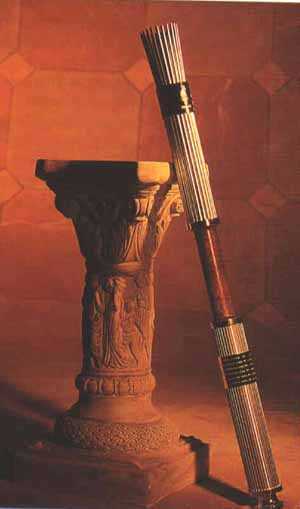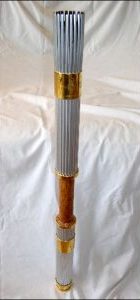Torch and Torch Relay
| The Lighting of the Flame
For each Olympiad, a flame is ignited from the sun`s rays in a historic ceremony dating back to 700 BC. The ceremony marks the beginning of the Flame Relay, and presents an opportunity for each organizing committee to pay homage to the legacy Greece has bequeathed to the modern Games. Following tradition, the majestic ceremony took place in the ancient stadium in the city of Olympia. It was attended by thousands of Greek citizens in a public celebration of Olympic ideals. After presentations by the Greek government, HOC, ACOG officials, and the first lady of the US, the high priestess and accompanying priestesses performed an ancient and private ritual in the Sacred Grove of Altis, invoking the Greek gods to bless the Games and light the flame. 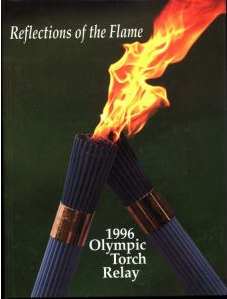
The flame was then presented for view to the public by the high priestess, and the first Greec torchbearer began the Flame Relay through Greece. This beautifully executed ceremony was a truly emotional experience for all who attended. The ACOG representatives returned to Atlanta energized for the final months before the Games. The portion of the relay that took place in Greece was the most extensive in history. At each relay stop, officials conducted a 15 - 20 minute public ceremony that included lighting a cauldron, raising the US and Greek flags, playing the national anthems, remarks by Greek dances, and gift exchanges between ACOG officials and the local government representative. The Flame Relay in Greece united ACOG and the HOC in respect and sentiment for the flame, epitomizing the true spirit of the Olympic Games. |
|
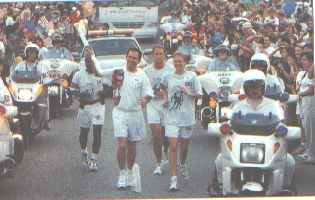
|

| Description: | 22 reeds represent the cities where Olympic Games were held since 1896. Gathered by 2 goldplated brass bands, the top band displays the Atlanta torch logo and the quilt of leaves design, the bottom band lists all Olympic cities since 1896. |
|---|---|
| Material: | Aluminum and Georgia pecan wood |
| Fuel: | |
| Torch measure: | Lenght: 80 cm Weight: 1,600 gr |
| Torches total: | |
| Design by: | Peter Mastrogiannis |
| Manufacturer: | |
| Date of the torch relay: | 30. March - 19. July 1996 |
| Duration: | days |
| Numbers of runners: | ~ 800 in Greece and 12.467 in USA |
| Distance total: | 2,141 outside USA 26,875 in USA |
| Name of the last runner: | Muhammad Ali |
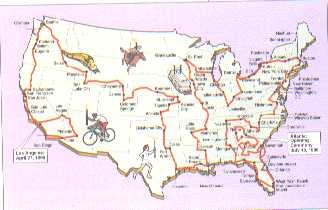
The US Route The US route, designed to reflect the geographic and social diversity of the country as well as its history, crossed deserts and prairies, wine country and farmland, rivers and lakes, and big cities and small towns. In addition to being carried by torchbearers, the flame traveled by train, steamboat, canoe, horseback, sailboat, and other modes of transportation that reflected the character and history of surrounding communities. The route included three US Olympic host cities: St. Louis (1904), Los Angeles 1932 and 1984), and Atlanta. Torch Relay staff resarched historical sites and key moments in US Olympic history to create a route that would showcase the US.In summer 1994, the senior manager of operations secretly journeyed cross-country to determine the initial proposed route and undertake an initial mileage measurement. He also drove the secondary roads to ensure the route was passable, tracked mileage for a preliminary distance estimate, and resarched local folklore and landmarks to choose celebration sites that ensured the route would pass by places important to the local pobulation. Many ideas generated on that drive were adopted in the final route. |
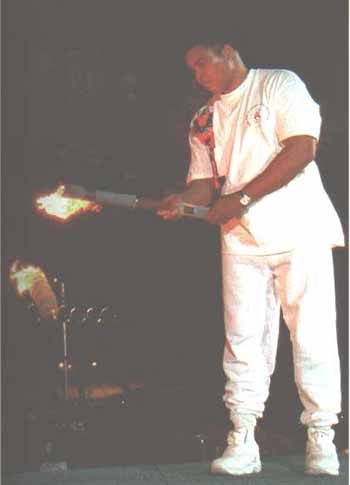 that will light the Olympic cauldron |
The most sacred, dramatic, and anticipated moment of the Opening Ceremony has arrived - the arrival of the Olympic flame. It has been 84 days since its arrival in the United States, which, together with the 16 days of competition to come, will equal a symbolic 100 days. In the US, the flame has traveled more than 16,000 miles (25,749 km) in a journey that will conclude momentarily in Atlanta. The stage is set, and 3.5 milliard people around the world, along with the assembled athletes of the XXVI Olympiad, eagerly await the sight of the torch being carried into the stadium by an asyet unknown runner. |
| Country | Date | Distance | Runners | Torches |
|---|---|---|---|---|
| Greece | 30.03. - 06.04.1996 | 2,141 km | 1800 | |
| 17 previous Olympic Cities |
07.04. - 26.04.1996 | |||
| USA | 27.04. - 19.07.1996 | 26,875 km | 12,467 | |
| Total | ~ 29,000 km | ~ 14,000 | ~ 5,000 |
Periodically throughout the evening, updates of the torch`s progress have been displayed on large screens inside Olympic Stadium. The final runner, four-time discus gold-medal winner Al Oerter, arrives at he stadium and ignites the torch held by another Olympic great, three-time heavyweight world champion boxer Evander Holyfield, a resident of Atlanta. Holyfield, whose identity as the runner who will enter the stadium with the torch has been kept secret, runs into the tunnel that will take him underground and finally up onto the huge raised platform in the center of the field. His surprise appearance is cheered heartily by the stadium audience and the assembled athletes surrounding the platform. Hoyfield leaves the platform and heads for the track, where he beckons runner Voula Patoulidou of Greece. Together, they carry the torch around the stadium track, where they meet another Olympic great, US swimmer Janet Evants, to whom they pass the torch. Accompanied by the strains of Beethoven`s "Ode to Joy," Evans holds the torch high as she begans her lap around the track. The cheers from the capacity crowd swell to a deafening roar, as if to propel Evans toward the long ramp leading up to the top of the north end of the stadium. The eyes of the world are literally focused on Evans as she begins to climb the long ramp. Suddenly appearing to the world, standing confidently at the top, is "The Greatest," the incomparable Muhammad Ali, whose presence draws a collective gasp and then a tumultuous roar from the crowd. Ali, the heavyweight boxing gold medalist at the 1960 Rome Games, is today regarded as the reatest professional heavyweight boxing champion of all time. Evans touches her torch to Ali`s igniting it. 'Trembling from the palsy that has gripped his body in recent years, Ali raises the torch triumphantly and is answered by wild, euphoric cheers from the audience. Then, in a magical sleight-of-hand, Ali slowly lowers his torch to ignite a special self-propelling torch that conveys the flame up a long cable to the waiting cauldron. The mechanical torch is ignited, and begins its journey up the high wire. When it reaches the cauldron`s edge, the flame races around the enormous spiral, setting each jet ablaze. Tears of joy flow easily and generously from the eyes of many spectators in the giant Olympic Stadium. This culminating moment, so completely unexpected in its final, emotionally charged twist, enthralls, fortifies, and unites the worldwide audience in a feeling that will be sustained troughout Atlanta`s Games. (Source document: Official
post report 1996, Published by Peachtree Publishers, 494 Armour Circle
NE, Atlanta, GA 30324) |

|
